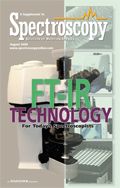Letter from the Editor
Whether used for traditional applications such as identifying counterfeit pharmaceuticals or in some of the more glamorous "CSI-type" forensic applications such as ink analysis, FT-IR technology continues to occupy a large and important space in the field of spectroscopy.
Whether used for traditional applications such as identifying counterfeit pharmaceuticals or in some of the more glamorous "CSI-type" forensic applications such as ink analysis, FT-IR technology continues to occupy a large and important space in the field of spectroscopy. And the fact that many are of the opinion that FT-IR may be nearing maturity can only bode well for its future, as the history of other mature technologies such as gas chromatography attests — being an industry standard for decades to come is good for business, to say the least.

David Walsh
Here in this supplement, Spectroscopy has assembled a collection of some of the newest and most cutting-edge applications of FT-IR spectroscopy in the field today, from thought leaders across the industry. In addition to the applications mentioned above, readers will find research on FT-IR used in the semiconductor industry, FT-IR for polymer research, and more.
In an uncertain marketplace, reliable and established techniques and instrumentation will always thrive, and FT-IR certainly fits this definition. And with application in massive markets such as the pharmaceutical industry and emerging, cutting-edge markets such as forensics, the future is even brighter. Readers can look for more on FT-IR in the September edition of Spectroscopy's e-newsletter, "The Wavelength," as that month's issue is dedicated to this technique. And as always, look for more FT-IR research in the pages of Spectroscopy in the coming months.
Enjoy the issue.

David Walsh
Editor-in-Chief

New AI Model Accelerates Infrared Imaging for Protein Analysis, Study Reveals
May 7th 2025A new study led by Ayanjeet Ghosh of the University of Alabama presents a transformative approach to analyzing infrared (IR) imaging data, with promising implications for neurodegenerative disease research.